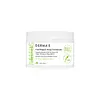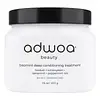What's inside
What's inside
 Key Ingredients
Key Ingredients

No key ingredients
 Benefits
Benefits

 Concerns
Concerns

 Ingredients Side-by-side
Ingredients Side-by-side

Water
Skin ConditioningCetearyl Alcohol
EmollientBehentrimonium Chloride
PreservativeRicinus Communis Seed Oil
MaskingHydrolyzed Vegetable Protein
Skin ConditioningCetyl Alcohol
EmollientGuar Hydroxypropyltrimonium Chloride
Skin ConditioningHydrolyzed Wheat Protein
Skin ConditioningButyrospermum Parkii Butter
Skin ConditioningCocos Nucifera Oil
MaskingPrunus Amygdalus Dulcis Oil
Skin ConditioningPhyllanthus Emblica Fruit Extract
HumectantPersea Gratissima Oil
Skin ConditioningVitis Vinifera Seed Oil
EmollientSimmondsia Chinensis Seed Oil
EmollientSclerocarya Birrea Seed Oil
HumectantAllantoin
Skin ConditioningBiotin
AntiseborrhoeicGlycerin
HumectantBehenyl Behenate
EmollientTocopheryl Acetate
AntioxidantArctium Lappa Root Extract
Skin ConditioningCoco-Caprylate
EmollientYucca Filamentosa Root Extract
Carica Papaya Fruit Extract
Skin ConditioningMangifera Indica Fruit Extract
Skin ConditioningMenthone Glycerin Acetal
RefreshingMenthol
MaskingMentha Arvensis Leaf Oil
MaskingMentha Piperita Leaf
RefreshingEthylhexylglycerin
Skin ConditioningPhenoxyethanol
PreservativeWater, Cetearyl Alcohol, Behentrimonium Chloride, Ricinus Communis Seed Oil, Hydrolyzed Vegetable Protein, Cetyl Alcohol, Guar Hydroxypropyltrimonium Chloride, Hydrolyzed Wheat Protein, Butyrospermum Parkii Butter, Cocos Nucifera Oil, Prunus Amygdalus Dulcis Oil, Phyllanthus Emblica Fruit Extract, Persea Gratissima Oil, Vitis Vinifera Seed Oil, Simmondsia Chinensis Seed Oil, Sclerocarya Birrea Seed Oil, Allantoin, Biotin, Glycerin, Behenyl Behenate, Tocopheryl Acetate, Arctium Lappa Root Extract, Coco-Caprylate, Yucca Filamentosa Root Extract, Carica Papaya Fruit Extract, Mangifera Indica Fruit Extract, Menthone Glycerin Acetal, Menthol, Mentha Arvensis Leaf Oil, Mentha Piperita Leaf, Ethylhexylglycerin, Phenoxyethanol
Water
Skin ConditioningButyrospermum Parkii Butter
Skin ConditioningCocos Nucifera Oil
MaskingBehentrimonium Methosulfate
Cetearyl Alcohol
EmollientCetyl Alcohol
EmollientGlycerin
HumectantGlyceryl Stearate
EmollientAdansonia Digitata Oil
EmollientPrunus Amygdalus Dulcis Oil
Skin ConditioningOpuntia Ficus-Indica Seed Oil
EmollientCetyl Esters
EmollientHydrolyzed Wheat Protein
Skin ConditioningCetrimonium Chloride
AntimicrobialBiotin
AntiseborrhoeicGuar Hydroxypropyltrimonium Chloride
Skin ConditioningCucurbita Pepo Seed Oil
EmollientCaprylyl Glycol
EmollientPhenoxyethanol
PreservativeGaultheria Procumbens Leaf Oil
MaskingMentha Piperita Oil
MaskingMentha Viridis Leaf Oil
AstringentQuaternium-80
Lavandula Spica Herb Oil
PerfumingRosmarinus Officinalis Leaf Oil
MaskingMenthol
MaskingWater, Butyrospermum Parkii Butter, Cocos Nucifera Oil, Behentrimonium Methosulfate, Cetearyl Alcohol, Cetyl Alcohol, Glycerin, Glyceryl Stearate, Adansonia Digitata Oil, Prunus Amygdalus Dulcis Oil, Opuntia Ficus-Indica Seed Oil, Cetyl Esters, Hydrolyzed Wheat Protein, Cetrimonium Chloride, Biotin, Guar Hydroxypropyltrimonium Chloride, Cucurbita Pepo Seed Oil, Caprylyl Glycol, Phenoxyethanol, Gaultheria Procumbens Leaf Oil, Mentha Piperita Oil, Mentha Viridis Leaf Oil, Quaternium-80, Lavandula Spica Herb Oil, Rosmarinus Officinalis Leaf Oil, Menthol
Ingredients Explained
These ingredients are found in both products.
Ingredients higher up in an ingredient list are typically present in a larger amount.
Biotin is a B vitamin that is naturally produced by our bodies. It is also called Vitamin H.
Our bodies use biotin in the metabolism process. It also helps our bodies use enzymes and move nutrients around. A biotin deficiency can lead to brittle hair and nails.
More research is needed on applying biotin topically. However, taking biotin orally has been shown to help nourish the skin, hair, and nails. They play a role in forming skin-hydrating fatty acids.
Biotin is water-soluble. It can be found in foods such as fish, eggs, dairy, nuts, and meat. Vitamin H stands for "haar" and "haut". These are the German words for hair and skin.
Learn more about BiotinThis ingredient is also known as shea butter. It is an effective skin hydrator and emollient.
Emollients help soothe and soften your skin. It does this by creating a protective film on your skin. This barrier helps trap moisture and keeps your skin hydrated. Emollients may be effective at treating dry or itchy skin.
Shea butter is rich in antioxidants. Antioxidants help fight free-radicals, or molecules that may harm the body. It is also full of fatty acids including stearic acid and linoleic acid. These acids help replenish the skin and keep skin moisturized.
While Shea Butter has an SPF rating of about 3-4, it is not a sunscreen replacement.
Shea butter may not be fungal acne safe. We recommend speaking with a professional if you have any concerns.
Learn more about Butyrospermum Parkii ButterCetearyl alcohol is a mixture of two fatty alcohols: cetyl alcohol and stearyl alcohol. It is mainly used as an emulsifier. Emulsifiers help prevent the separation of oils and products. Due to its composition, it can also be used to thicken a product or help create foam.
Cetearyl alcohol is an emollient. Emollients help soothe and hydrate the skin by trapping moisture.
Studies show Cetearyl alcohol is non-toxic and non-irritating. The FDA allows products labeled "alcohol-free" to have fatty alcohols.
This ingredient is usually derived from plant oils such as palm, vegetable, or coconut oils. There is debate on whether this ingredient will cause acne.
Due to the fatty acid base, this ingredient may not be Malassezia folliculitis safe.
Learn more about Cetearyl AlcoholCetyl Alcohol is a fatty alcohol. Fatty Alcohols are most often used as an emollient or to thicken a product.
Its main roles are:
Though it has "alcohol" in the name, it is not related to denatured alcohol or ethyl alcohol.
The FDA allows products labeled "alcohol-free" to have fatty alcohols.
Learn more about Cetyl AlcoholCocos Nucifera Oil is obtained from the kernels of the coconut fruit. In other words, this is coconut oil.
Coconut Oil is rich in fatty acids with lauric acid making up the majority of these. It also contains linoleic acid. Due to this high fatty acid content, coconut oil helps trap moisture and soften skin.
Despite being antibacterial, coconut oil may not be great for acne-prone skin. It is comedogenic and may clog pores. This ingredient may not be safe for malassezia or fungal acne.
Note: Coconut Oil should not replace your sunscreen for UV protection. Studies show it only blocks about 20% of UV.
This oil is non-volatile and has a light scent.
The term 'fragrance' is not regulated in many countries. In many cases, it is up to the brand to define this term. For instance, many brands choose to label themselves as "fragrance-free" because they are not using synthetic fragrances. However, their products may still contain ingredients such as essential oils that are considered a fragrance.
Learn more about Cocos Nucifera OilGlycerin is already naturally found in your skin. It helps moisturize and protect your skin.
A study from 2016 found glycerin to be more effective as a humectant than AHAs and hyaluronic acid.
As a humectant, it helps the skin stay hydrated by pulling moisture to your skin. The low molecular weight of glycerin allows it to pull moisture into the deeper layers of your skin.
Hydrated skin improves your skin barrier; Your skin barrier helps protect against irritants and bacteria.
Glycerin has also been found to have antimicrobial and antiviral properties. Due to these properties, glycerin is often used in wound and burn treatments.
In cosmetics, glycerin is usually derived from plants such as soybean or palm. However, it can also be sourced from animals, such as tallow or animal fat.
This ingredient is organic, colorless, odorless, and non-toxic.
Glycerin is the name for this ingredient in American English. British English uses Glycerol/Glycerine.
Learn more about GlycerinThis ingredient is derived from guar gum.
It is a conditioning ingredient, meaning it helps soften skin and hair.
We don't have a description for Hydrolyzed Wheat Protein yet.
Menthol is a compound found in mint plants, such as peppermint. In its pure form, it is a clear crystalline substance.
Menthol is known for its cooling sensation; however, the cooling is actually from your skin being sensitized. Menthol can worsen rosacea. We recommend speaking with a professional if you have concerns.
Menthol also has antimicrobial properties.
Learn more about MentholPhenoxyethanol is a preservative that has germicide, antimicrobial, and aromatic properties. Studies show that phenoxyethanol can prevent microbial growth. By itself, it has a scent that is similar to that of a rose.
It's often used in formulations along with Caprylyl Glycol to preserve the shelf life of products.
Prunus Amygdalus Dulcis Oil comes from the sweet almond, a tree native to Iran. This oil has no fragrance and is non-volatile.
Almonds contain healthy fats, vitamins, and minerals. It is a rich source of Vitamin E, a great antioxidant and skin conditioning ingredient. Sweet almond oil contains fatty acids such as linolenic acid and triglycerides.
The content of sweet almond oil makes it a great emollient; it can help soften and hydrate your skin. Emollients create a barrier over your skin to trap moisture in. Sweet almond oil has antioxidant properties.
Those with an almond allergy should be careful of this ingredient and speak with a professional about using it in your skincare.
This ingredient may not be fungal-acne safe.
Learn more about Prunus Amygdalus Dulcis OilWater. It's the most common cosmetic ingredient of all. You'll usually see it at the top of ingredient lists, meaning that it makes up the largest part of the product.
So why is it so popular? Water most often acts as a solvent - this means that it helps dissolve other ingredients into the formulation.
You'll also recognize water as that liquid we all need to stay alive. If you see this, drink a glass of water. Stay hydrated!
Learn more about Water